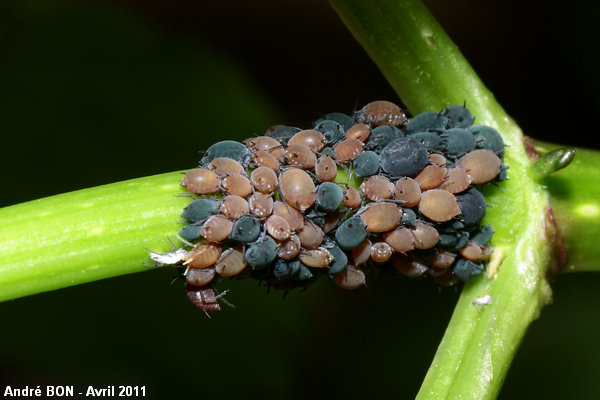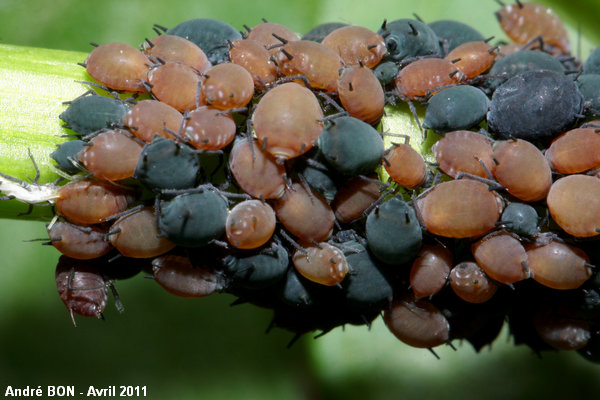


| Elder aphid (Aphis sambuci (Linnaeus, 1758)) |



|
|
Scientific name: Aphis sambuci (Linnaeus, 1758) Common name: Elder aphid French name: Puceron du sureau, Puceron noir du sureau Order: Hemiptera Family: Aphididae Wingspan : 2.2 to 3.5 mm Biotope: Mainly on Black Elder (Sambucus nigra), but also on other plants like Sorrels (Rumex sp), sinapis sp., etc. Geographic area: Holarctic region, missing in Japan and Korea. Observation period : A first brood hatch out on Black Elder between March and May. Members of the second brood are wingless, those of the following broods have wings. Early July aphids leave Black Elders to move to summer host plants like Sorrels. They come back to Black Elders at mid September and females lay their eggs there between mid October and early November. The eggs over winter and the next brood will hatch out at next spring. |
Elder aphids gather in tight groups to form some kind of small tubes around young shoots of Elders in spring. They collect there a toxic substance, called sambunigrine, which protects them against many predators. They are also often protected by ants which collect their honeydew. Elder aphids can pullulate in plantations and cause important damages. They weaken plants by feeding on sap. The wingless forms on Elder are black, yellowish green or yellowish brown. They sometimes show traces of whitish or greyish wax. The cornicles are thin and long. The wingless forms on summer plants are a smaller size. They are blue green. |
| [To know more about the Elder aphid] [Next picture] [Top] |

|
A colony of aphids on a Black Elder young shoot, forming a tight tube-shaped group, I have immediately thought to the Elder aphid species. While searching information to confirm the species, I haven't found any picture with pale brown aphids. So I have asked an expert who has confirmed the fact that these aphids may change of colour depending on their development stages. |
| [To know more about the Elder aphid] [Next picture] [Previous picture] [Top] |

|
The Black Elder on which I have observed these aphids didn't seem to have suffered of these parasitic insects. |
| [To know more about the Elder aphid] [Previous picture] [Top] |

|
Every year I am used to making an elderflower aperitif. I try to collect flowers without aphids, but this year I still had a few. I spared them a dip in white wine and took the opportunity to take a close-up photo. |